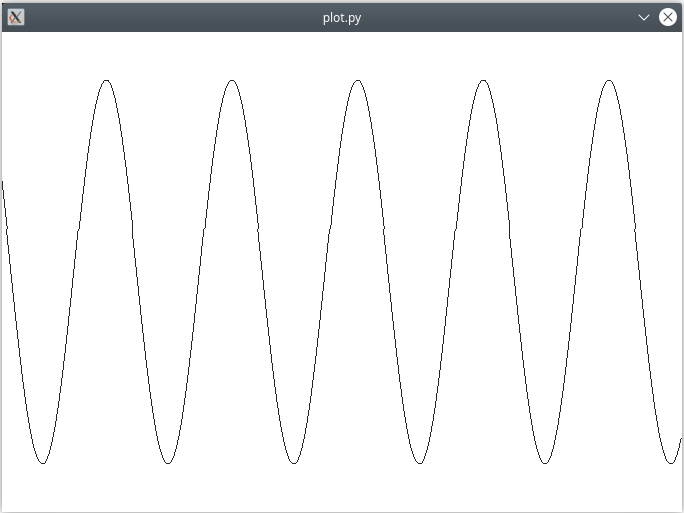Plot Example¶
The Plot example shows how to display a graph from data using an opaque container.
It draws an sine graph using QPainter.drawPolyline() from a list of points.
The list of points is continuously updated, as is the case for a example for a
graph of an oscilloscope or medical patient monitor.
In this case, it makes sense from a performance point of view to avoid the
conversion of a Python list of data to a C++ list (QList<QPoint>)
for each call to the plot function QPainter.drawPolyline().
This is where opaque containers come into play.
Instead of Python list of points, a QPointList is instantiated to store
the data. QPointList is an opaque container wrapping a QList<QPoint>.
It can be passed to QPainter.drawPolyline() instead of a Python list of
points.
The type is declared in the entry for the QList container type in the
type system file of the QtCore library:
<container-type name="QList" type="list"
opaque-containers="int:QIntList;QPoint:QPointList;QPointF:QPointFList">
...
</container-type>
In the shift() member function, new data are appended to the list while
old data moving out of the visible window are removed from the front of the
list.

# Copyright (C) 2022 The Qt Company Ltd.
# SPDX-License-Identifier: LicenseRef-Qt-Commercial OR BSD-3-Clause
from __future__ import annotations
import math
import sys
from PySide6.QtWidgets import QWidget, QApplication
from PySide6.QtCore import QPoint, QRect, QTimer, Qt
from PySide6.QtGui import QPainter, QPointList
WIDTH = 680
HEIGHT = 480
class PlotWidget(QWidget):
"""Illustrates the use of opaque containers. QPointList
wraps a C++ QList<QPoint> directly, removing the need to convert
a Python list in each call to QPainter.drawPolyline()."""
def __init__(self, parent=None):
super().__init__(parent)
self._timer = QTimer(self)
self._timer.setInterval(20)
self._timer.timeout.connect(self.shift)
self._points = QPointList()
self._points.reserve(WIDTH)
self._x = 0
self._delta_x = 0.05
self._half_height = HEIGHT / 2
self._factor = 0.8 * self._half_height
for i in range(WIDTH):
self._points.append(QPoint(i, self.next_point()))
self.setFixedSize(WIDTH, HEIGHT)
self._timer.start()
def next_point(self):
result = self._half_height - self._factor * math.sin(self._x)
self._x += self._delta_x
return result
def shift(self):
last_x = self._points[WIDTH - 1].x()
self._points.pop_front()
self._points.append(QPoint(last_x + 1, self.next_point()))
self.update()
def paintEvent(self, event):
with QPainter(self) as painter:
rect = QRect(QPoint(0, 0), self.size())
painter.fillRect(rect, Qt.GlobalColor.white)
painter.translate(-self._points[0].x(), 0)
painter.drawPolyline(self._points)
if __name__ == "__main__":
app = QApplication(sys.argv)
w = PlotWidget()
w.show()
sys.exit(app.exec())